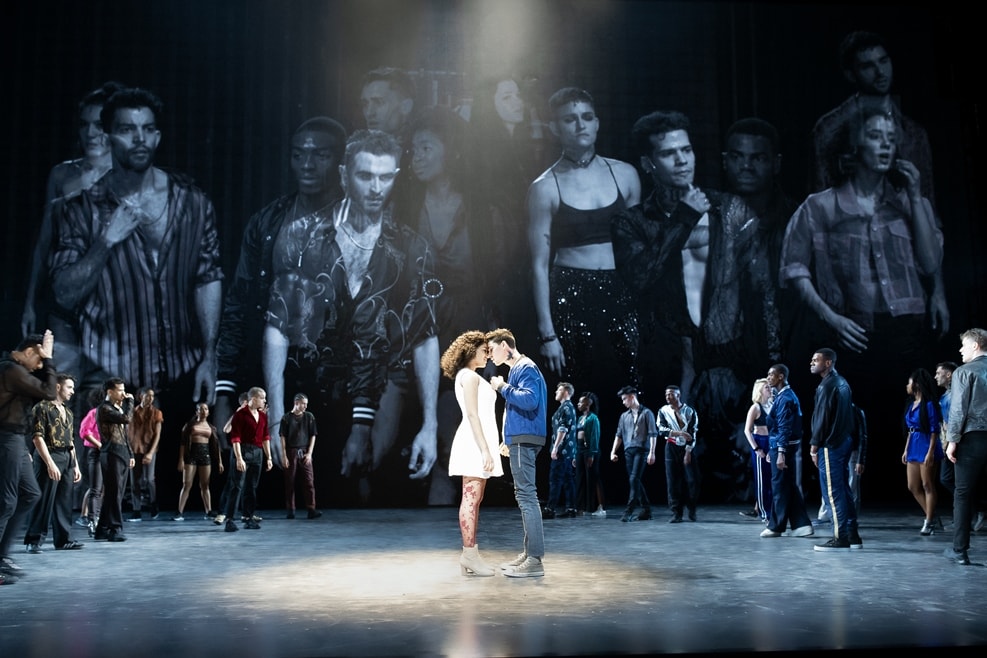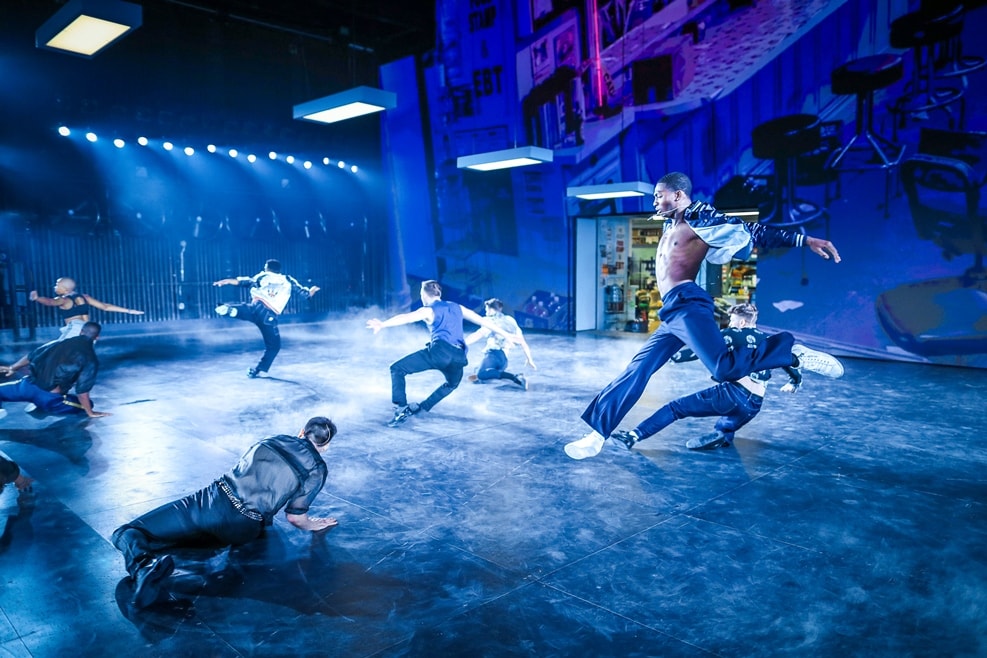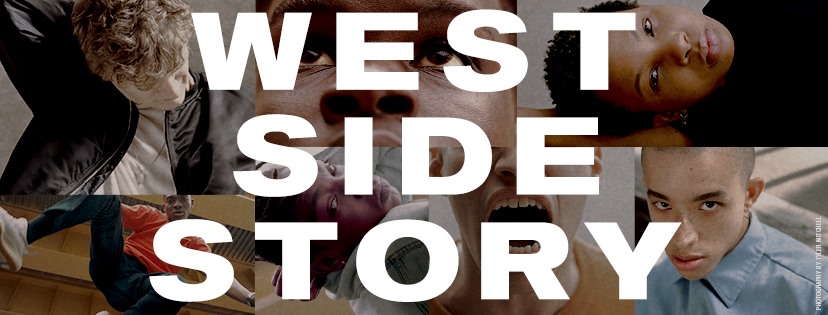Trouble and controversy have plagued Belgian director Ivo van Hove’s re-envisioned revival of West Side Story, playing an open-ended run at the Broadway Theatre, since the beginning, with a delayed opening, cast injuries, and the divisive casting, support, and retention of Amar Ramasar – a featured actor, who, as a principal dancer with the New York City Ballet, was accused of exchanging salacious texts and explicit nude photos of female dancers with a male colleague, without the women’s knowledge or prior consent, which has generated a movement, both on social media and in live daily protests, calling for his removal and a boycott of the show. Also at issue is van Hove’s imposition of his signature style of radical revisionism, with pared-down bare-bones staging that diminishes the richness of the original story and an overwhelming (over)use of video projections that detracts from the experience of live theater. All are valid points of critical contention, in a production that has people talking. Loudly.

The present iteration of the 1957 classic by the iconic team of Jerome Robbins (concept, direction, and choreography), Arthur Laurents (book), Leonard Bernstein (music), and Stephen Sondheim (lyrics) updates the mid-century setting of the creators’ already updated musical translation of Shakespeare’s tragedy of Romeo and Juliet to our current post-modern time, in a tale of the young love of Tony and Maria doomed by hatred. The opposing forces are two battling gangs – the Sharks, of which Tony is a member, all born on the American mainland, versus the Puerto-Rican-born Jets (as duly noted, also American), led by Maria’s brother Bernardo – which, as in the original, continues to spotlight the indefensible discrimination and loathing faced by Latinos and immigrants.
In keeping with the current resetting, costumes by An D’Huys, hair and wigs by Mia M. Neal, and make-up and tattoos by Andrew Sotomayor have the look of the latest 21st-century street-gang chic. But now the opposing gangs are multiracial and are not identified by the specific color of their clothes, just by their tattoos, which makes it difficult to tell them apart from a distance (the smart implication being that they’re – we’re – all really not that different from each other). And a towering upstage projection screen presents a videotaped backdrop of the present-day streets of New York (sometimes inexplicably in motion), in Luke Halls’ overpowering and upstaging video design.
For some scenes – when not showing gigantic close-ups of the actors, which dominate and distract from the live action and feel rife with self-indulgent gimmickry, not relevance (as videography was in van Hove’s direction of the media-themed Network) – a relatively tiny panel in the huge upstage screen opens up, in Jan Versweyveld’s minimalist set design, to reveal part of a distant dollhouse-like interior, and only part of the action; the rest, executed behind the screen or shot previously, is, too, projected in monumental scale in live-feed or pre-recorded video. While there are a few segments with germane references to the widespread popularity of digital media, as when members of the gang pull out their cell phones to record evidence of police brutality (reiterated with pre-recorded background projections of similar events), the over-reaching presence of videos more often than not raises the question, why not just stay home and watch TV or go see an IMAX movie (for a dramatically lower ticket price)?
Despite all its efforts to be cutting edge, there’s still that elephant in the room. If the production were truly au courant and dedicated to the ancient maxim of “ars simia naturae” it would acknowledge the validity of the #MeToo and #TimesUp movements and the protestors who continue to stand outside the theater at every performance, encouraging audiences to #BooBernardo. That’s also what’s happening now in our country. Instead, the song “I Feel Pretty” has been eliminated – a small concession to feminism in a show that exemplifies toxic masculinity, with its reworked graphic scenes of heightened violence and gang rape.
Aside from the socio-political implications of the plot (and the casting), Bernstein’s vibrant score, with some modifications, is as vital and affecting as ever, as played by the full orchestra (under the musical supervision and direction of Alexander Gemignani), but Robbins’ dazzling choreography has been replaced by the work of Anne Teresa de Keersmaeker. The cool snapping and movement of the “Prologue” are gone, as is the famed balcony scene, which is now staged as a tug of war between the two gangs that tear Tony and Maria apart, and the dancing, with an occasional nod to Robbins’ original balletic beauty and coordinated menace of the young hoodlums, is largely uninspired and tedious freestyle, with group numbers that are often jarringly out of synch.

The lackluster performance, by a large and mostly emerging ensemble (with 33 making their Broadway debuts), generally suffers from an absence of the star quality of seasoned professionals (perhaps a conscious decision in casting, to evoke the youthful inexperience of misguided teenagers), of triple threats in a show that requires singing, dancing, and acting, and of chemistry in a theme that revolves around first love. Dharon E. Jones as the Jets leader Riff and Yesenia Ayala as Bernardo’s girlfriend Anita are the standout dancers, and the semi-operatic soprano voice of Shereen Pimentel, who plays Maria, is the most noteworthy among the singers, though the duets and group harmonies, with the exception of the lively “America” – performed here as a musical debate between the male Sharks and their female coterie – are anything but, lacking the control and precision expected in a Broadway production.
Isaac Powell’s Tony is portrayed as more childish than naïve (his delivery of the starry-eyed love song “Maria” is laughably juvenile by intention), and Pimentel’s Maria is made more outspoken and daring than in previous productions, but still seems more girlishly petulant than empowered. Ayala is once again the standout in her fiery and expressive characterization of Anita, while Ramasar, feigning a faulty accent, brings little acting or vocal skill to his role as Bernardo to justify his presence.
Van Hove’s much debated reinvention of West Side Story at the Broadway Theatre is a show that elicits strong reactions and opinions; most likely you will either love it or hate it. I didn’t love it.
Running Time: Approximately one hours and 40 minutes, without intermission.
West Side Story plays an open-ended run, performing at the Broadway Theatre – 1681 Broadway, NYC. For tickets, call (800) 447-7400, or purchase them online.





